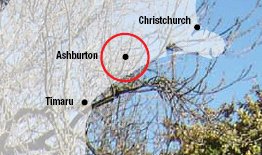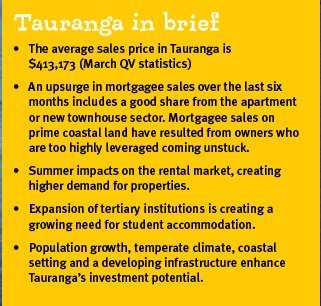Landlords.co.nz
Traditionally touted for its relating lifestyle, Tauranga City offers more than the sun and surf to active investors, writes Adrienne Jervis.
In little over 25 years, sunny Tauranga city, Bay of Plenty's largest populated centre, has tripled in size.
With a population estimate of 118,200, it is the ninth largest New Zealand city and the centre of the country's fifth largest urban area. But has a cloud descended on the popular lifestyle city's property market?
QV research director, Jonno Ingerson and Tauranga QV valuer, Shayne Donovan-Grammar, say that unlike many of the other main centres, there has been very little recovery in values since the market low and values are still 9.70% below the market peak.
"Based on our house price index (not average sales prices), from the peak of the market in late 2007 to the low in early 2009, property values in Tauranga dropped 10.80%."
QV reports that when the market was near its value peak in 2006, house sales volumes in Tauranga were around 800 per quarter. During 2008 these volumes fell to around 400 to 450 houses per quarter, before recovering to between 550 and 600 per quarter in 2009. The start of 2010 has seen relatively subdued sales volumes.
While first home buyers and owners upgrading to the next level of property are still relatively active, investors are very quiet and are unsure what to make of the proposed tax changes. Apartment and high end property buyers are reportedly in short supply, but there is slightly more activity from buyers purchasing sections compared to this time last year.
Spec building, which has historically been a big sector in this region, has decreased significantly over the last two years. With prices softening, newer existing homes became affordable to the point where there was little or no margin for the spec builder to work with.
Like apartments, sections were targeted by speculators during the boom. They would put a small deposit down, expecting to enjoy capital gain while the subdivision was developed.
"Section prices have come back more than the average house has," says Donovan-Grammar.
"As investors are unable to get an income off a section, it makes them a more vulnerable property type."
Much of Tauranga's strong population growth from the mid-1990s through until early last decade was based around its popularity as a retirement destination, particularly for Aucklanders, according to Gareth Kiernan, managing director of Infometrics.
Although its appeal amongst retirees has slightly waned as they've looked for alternatives such as Coromandel and Northland, population growth has held up reasonably well, facilities have expanded and Tauranga is now generally regarded as an area with a range of employment prospects and a good lifestyle.
Economic growth
The population growth has provided a solid base for economic growth.
"The fact that the population is growing means that aggregate economic growth will be faster," says Kiernan.
The city's expansion means that it is similar in many respects to Hamilton or Christchurch in terms of what drives growth.
"The health of exporters is important in determining the health of the broader Bay of Plenty region. Good export incomes feed through into spending in the city, but there is a growing base of domestically focused activity in the city that operates reasonably independently from the export sector."
The port is a major player for Tauranga's economy and its growing market share over the last 15 years has definitely benefited the city. Forestry, horticulture and agriculture are important for the port and the city's economy. And despite the broader global down-turn, China's demand for logs has likely impacted favourably upon the Port of Tauranga.
Kiernan believes that due to the overrepresentation of older people, lower interest rates are probably less positive for Tauranga than for some other areas, as older people are often partially reliant on interest rates/savings for their incomes.
Infrastructure
The government's inclusion of the Tauranga Eastern Corridor as a Road of National Significance is important for improving the area's infrastructure, which has struggled to keep up with the strong population growth. The Northern Arterial route, currently outside NZTA's 10-year plan, is also a key project.
"Development of these roads will improve the attractiveness of living in areas serviced by the roads, reducing commuting times, and thus having a positive effect on property values in these locations over the medium term," says Kiernan.
Property market
Strong population growth over the last 10 to 15 years created a relatively high level of speculative development. However, the impact of the financial crisis has impeded development and the supply of new houses is now relatively limited.
Mark Power, general manager Quinovic Property Management Tauranga, says positive cash flow properties are harder to come by although the city has enjoyed good capital gains in many areas.
Rents from around March 2009 dropped slightly leading into last winter, coinciding with large numbers of properties being added to the rental pool. Despite a few exceptions, rents have since remained fairly static.
Tidy, warm and dry homes with three bedrooms-plus in areas close to schools and amenities are the easiest to rent out and the most in demand. Demand and supply has remained reasonably constant over the last few months.
Power says properties available to rent on Trade Me have stayed around the $300 mark apart from a dip in January to about $250, which is pretty normal.
"There is always more demand in January."
Although tenants have become more choosy, properties in sought-after locations continue to attract multiple applications and have held their rents well with some actually going up.
Dan Keller, president of Tauranga's Property Investors' Association for the past seven years, has been investing in the local market since 1994 as he believes in the future growth of the area. But the market of late has been very slow.
"We're not seeing a lot of Sold signs."
His advice to investors is that they should be out there looking.
"Do your homework and have your finances organised. Cash buyers will find some beauties."
He says that with very few looking, it's a good time to "line your ducks up" and be ready to make a move.
Keller believes Tauranga's long-term prospects are very good and that Priority One will bring economic growth and development. Priority One, the economic development organisation covering Tauranga and the Western Bay of Plenty which was established by the business community, is half funded by business membership making it a unique structure in New Zealand.
It is also contracted to deliver economic outcomes by Tauranga City and Western Bay of Plenty District councils. With key focus areas including the establishment of tertiary education and research provision to accelerate innovation and entrepreneurship, and the growth of export-focused industry clusters, long-term employment opportunities and population growth look promising.
Migrants favour the area for its lifestyle and security, and a diversity of buyers, including many families, is evident. Keller says Tauranga has a cross section of tenants and a current shortage of rental properties.
Neville Falconer, principal of LJ Hooker Realtylink Tauranga and vice president of the Real Estate Institute of New Zealand, describes the Tauranga market as steady but at relatively low sales volumes.
"Current potential is strongest in distressed sales situations."
Falconer says longer term, the Tauranga market has proven itself to out-perform the average because of its amenities, local industry and continued population growth.
"There is a horticultural theme in Tauranga that attracts investment buyers to house workers. The retirement market is still strong and retirees bring capital investment with them."
Rental incomes
An average three-bedroom house sells for $300,000 to $350,000 and these properties rent for around $320 per week giving a gross return of around 5.50% to 6% before capital gain.
Rentals most in demand are average three-bedroom homes in good areas, including family homes close to good schooling and public transport. The Avenues and central CBD are popular locations and easier to rent out. Properties in poor condition with little or no maintenance done are difficult to find good tenants for.
Outlook
Assuming population growth continues to be relatively good, Tauranga shapes as a reasonably good place to invest compared with many other areas, says Kiernan.
"As with any other area, immediate prospects are questionable given the likely tax changes, but long-term prospects look positive due to investment in infrastructure by government and ever-improving lifestyle offered by Tauranga."
Kiernan believes that Tauranga's coastal location and good climate means that it could rival Hamilton for size over a 30 to 50-year horizon, although the proximity and better access to Auckland are advantages for Hamilton.
Ingerson reckons Tauranga has more potential than almost any other area of New Zealand due to it being one of the country's fastest growing areas, its good climate, room to expansion, developing infrastructure, coastal setting, popular retirement area and holiday destination.
"There will be a lot of opportunities in the property sector for both developers and investors in the medium to long term. Although from an investor's point of view, it is difficult to find property with reasonable returns."
Source: Landlords.co.nz
Need help or
support?